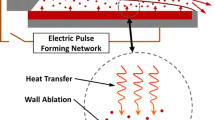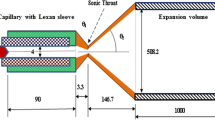Abstract
Electrothermal (ET) plasma discharges are emerging as valuable mechanisms for pellet injection in magnetic confinement fusion reactors. They have been shown to be capable of achieving the required pellet velocities and pellet launch frequencies required for edge localized mode control. Another advantage of ET plasma discharges is their ability to simulate fusion disruption events by depositing large heat fluxes on exposed materials. A deeper understanding of the heat transfer processes occurring in ET plasma discharges will aid in this particular application. ET plasma discharges involve the passage of high currents (order of tens of kA) along the axis of a narrow, cylindrical channel. As the current passes through the channel, radiant heat is transferred from the plasma core to the capillary wall. Ablated particles eventually fill the plasma channel and the partially ionized plasma is ejected. It is well known that the ablated material separating the plasma core from the ablating surface can act as a vapor shield and limit the radiation heat flux reaching the ablating surface. In this work, the results from a two-dimensional simulation model for ET plasma discharges are presented. The simulation of the plasma in a two-dimensional domain combined with the diffusion approximation for radiation heat transfer is shown to successfully simulate the effects of the vapor shield layer that develops inside these devices.







Similar content being viewed by others
References
N. AlMousa, L. Winfrey, J.G. Gilligan, M.A. Bourham, Radiative heat transport through vapor plasma for fusion heat flux studies and electrothermal plasma sources applications. J. Nucl. Energy Sci. Power Gener. Technol. 3(1), 1–7 (2014)
M.A. Bourham, O.E. Hankins, O. Auciello, J.M. Stock, B.W. Wehring, R.B. Mohanti, J.G. Gilligan, Vapor shielding and erosion of surfaces exposed to a high heat load in an electrothermal accelerator. IEEE Trans. Plasma Sci. 17(3), 386–391 (1989)
J. Eapen, Theoretical and Numerical Foundations for Simulation of Ablative Plasma Flow in Electrothermal-Chemical Mass Accelerators. Master’s thesis (North Carolina State University, Raleigh, NC, 1998)
J.R. Echols, A.L. Winfrey, Surface effects of low incident angle, high heat flux plasma on tungsten utilizing an electrothermal source. Manuscript submitted for publication
J.R. Echols, A.L. Winfrey, Ablation of fusion materials exposed to high heat flux in an electrothermal plasma discharge as a simulation for hard disruption. J. Fusion Energy 33, 60–67 (2014)
C.M. Edwards, M.A. Bourham, J.G. Gilligan, Experimental studies of the plasma-propellant interface for electrothermal-chemical launchers. IEEE Trans. Magn. 31(1), 404–409 (1995)
M.J. Esmond, A.L. Winfrey, Estimation of transient effects of >2 mm radii in electrothermal plasma launchers for fusion fueling. Trans. Am. Nucl. Soc. 113, 381–384 (2015). Washington, D.C., November 8–12, 2015
M.J. Esmond, A.L. Winfrey, Flow characteristics and charge exchange effects in a two-dimensional model of electrothermal plasma discharges. J. Fusion Energy 35(2), 244–252 (2015)
T.E. Gebhart, R.T. Holladay, M.J. Esmond, A.L. Winfrey, Optimization of fusion pellet launch velocity in an electrothermal mass accelerator. J. Fusion Energy 33(1), 32–39 (2014)
J. Gilligan, M.A. Bourham, The use of an electrothermal plasma gun to simulate the extremely high heat flux conditions of a tokamak disruption. J. Fusion Energy 12(3), 311–316 (1993)
J. Gilligan, D. Hahn, R. Mohanti, Vapor shielding of surfaces subjected to high heat fluxes during a plasma disruption. J. Nucl. Mater. 162–164, 957–963 (1989). doi:10.1016/0022-3115(89)90393-0
J.G. Gilligan, R.B. Mohanti, Time-dependent numerical simulation of ablation-controlled arcs. IEEE Trans. Plasma Sci. 18(2), 190–197 (1990)
D. Hahn, J.G. Gilligan, Radiation transport through a plasma boundary layer between armatures and material surfaces. IEEE Trans. Magn. 27(1), 251–256 (1991)
J.D. Hurley, M.A. Bourham, J.G. Gilligan, Numerical simulation and experiment of plasma flow in the electrothermal launcher sirens. IEEE Trans. Magn. 31(1), 616–621 (1995)
E.Z. Ibrahim, The ablation dominated polymethylmethacrylate arc. J. Phys. D Appl. Phys. 13, 2045–2065 (1980)
R.W. Kincaid, M.A. Bourham, Electrothermal plasma gun as a pellet injector. J. Fusion Technol. 26(3), 637–641 (1994)
P. Kovitya, J.J. Lowke, Theoretical predictions of ablation-stabilised arcs confined in cylindrical tubes. J. Phys. D Appl. Phys. 17, 1197–1212 (1984)
X. Li, R. Li, S. Jia, Y. Zhang, Interaction features of different propellants under plasma impingement. J. Appl. Phys. 112(063303), 1–8 (2012)
R. Mohanti, Time Dependent Numerical Simulation of Nonideal Plasmas in Ablation Controlled Arcs. Ph.D. thesis (North Carolina State University, Raleigh, NC, 1990)
H. Ngo, M. Bourham, J. Doster, Heat and current transport in a metal-vapor electrothermal plasma source for electrothermal-chemical guns, in 35th JANNAF Combustion Subcommittee Meeting, (Tucson, AZ, 1998), pp. 187–197
L. Niemeyer, Evaporation dominated high current arcs in narrow channels. IEEE Trans. Power Appar. Syst. 97(3), PAS-950–958 (1978)
N. Orton, Boundary Layer Energy Transport in Plasma Devices. Ph.D. thesis (North Carolina State University, Raleigh, NC, 2000)
L. Pekker, Zero-dimensional time-dependent model of high-pressure ablative capillary discharge for plasma thrusters. J. Propuls. Power 25(4), 958–969 (2009)
L. Pekker, O. Pekker, Model of high-pressure ablative capillary discharge for plasma thrusters. J. Propuls. Power 27(2), 477–484 (2011)
A. Porwitzky, M. Keidar, I. Boyd, Progress towards an end-to-end model of an electrothermal chemical gun. IEEE Trans. Magn. 45(1), 412–416 (2009). doi:10.1109/TMAG.2008.2008688
C.B. Ruchti, L. Niemeyer, Ablation controlled arcs. IEEE Trans. Plasma Sci. PS–14(4), 423–434 (1986)
M. Ryan, The interaction of an electrothermal plasma with ja2 solid propellant. Ph.D. thesis (The University of Texas at Austin, Austin, TX , 2006)
A.L. Winfrey, M.A. Al-Halim, A.V. Saveliev, J.G. Gilligan, M.A. Bourham, Enhanced performance of electrothermal plasma sources as fusion pellet injection drivers and space based mini-thrusters via extension of a flattop discharge current. J. Fusion Energy 32, 371–377 (2013)
A.L. Winfrey, M.A.A. Al-Halim, J.G. Gilligan, A.V. Saveliev, M.A. Bourham, A study of plasma parameters in a capillary discharge with calculations using ideal and nonideal plasma models for comparison with experiment. IEEE Trans. Plasma Sci. 40(3), 843–852 (2012)
A.L. Winfrey, J.G. Gilligan, M.A. Bourham, A computational study of a capillary discharge pellet accelerator concept for magnetic fusion fueling. J. Fusion Energy 32, 227–234 (2013)
M.R. Zaghloul, Improved modelling of electrothermal plasma source with radiation transport. J. Phys. D Appl. Phys. 41(225206), 1–10 (2008)
M.R. Zaghloul, M.A. Bourham, J.M. Doster, Semi-analytical modelling and simulation of the evolution and flow of ohmically-heated non-ideal plasmas in electrothermal guns. J. Phys. D Appl. Phys. 34, 772–786 (2001)
Y. Zeldovich, Y. Raizer, Physics of Shock Waves and High Temperature Hydrodynamic Phenomena, vol. 1 (Academic Press, New York, 1966)
Acknowledgments
This work is made possible by the Nuclear Engineering Programs at Virginia Tech and The University of Florida. The authors acknowledge the resources provided by Advanced Research Computing at Virginia Tech and NSF grant CNS-0960081 and the HokieSpeed supercomputer at Virginia Tech.
Author information
Authors and Affiliations
Corresponding author
Rights and permissions
About this article
Cite this article
Esmond, M., Winfrey, L. Radiation Heat Transfer and Vapor Shielding in a Two-Dimensional Model of an Electrothermal Plasma Source. J Fusion Energ 35, 643–651 (2016). https://doi.org/10.1007/s10894-016-0089-7
Published:
Issue Date:
DOI: https://doi.org/10.1007/s10894-016-0089-7




